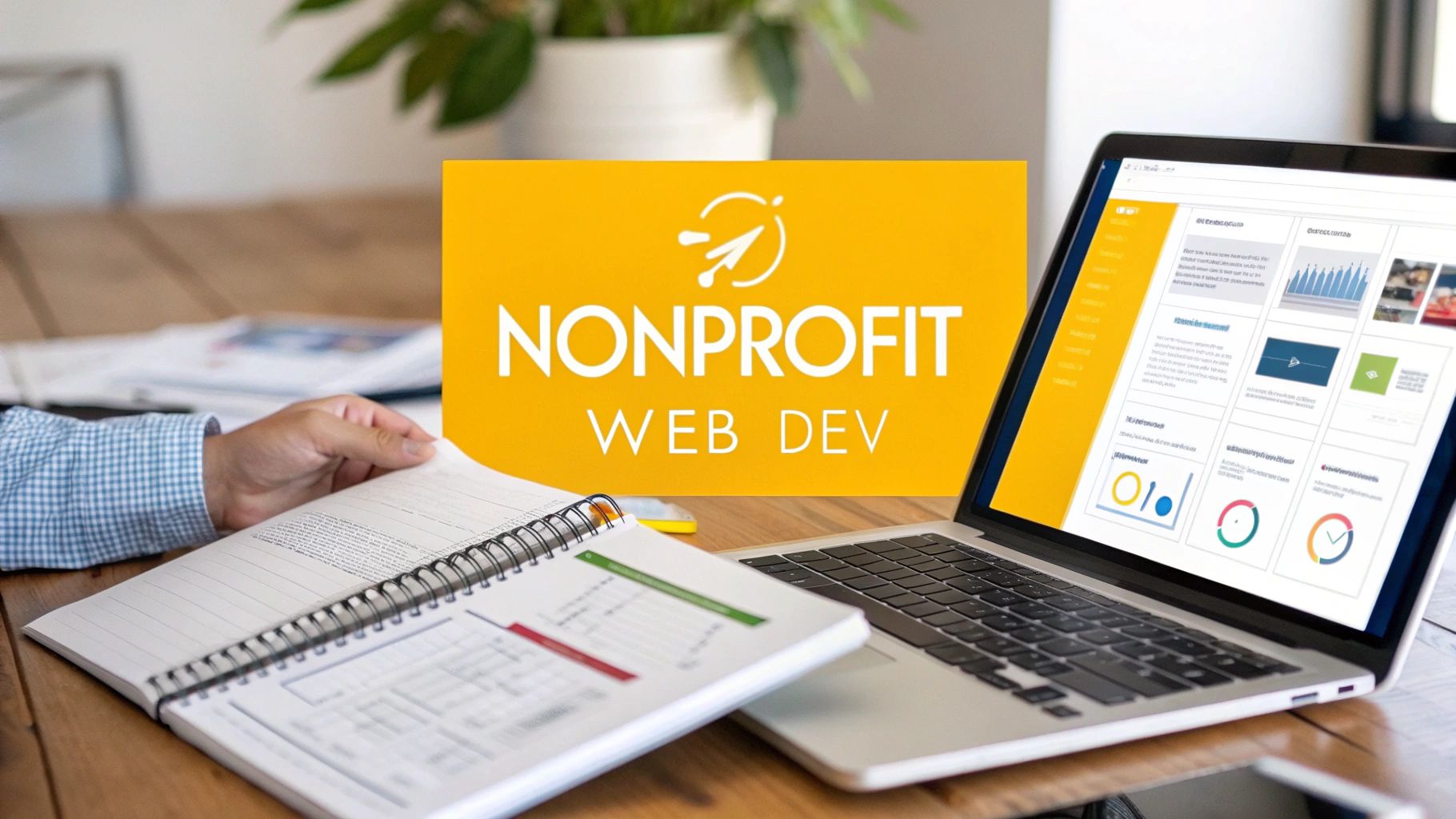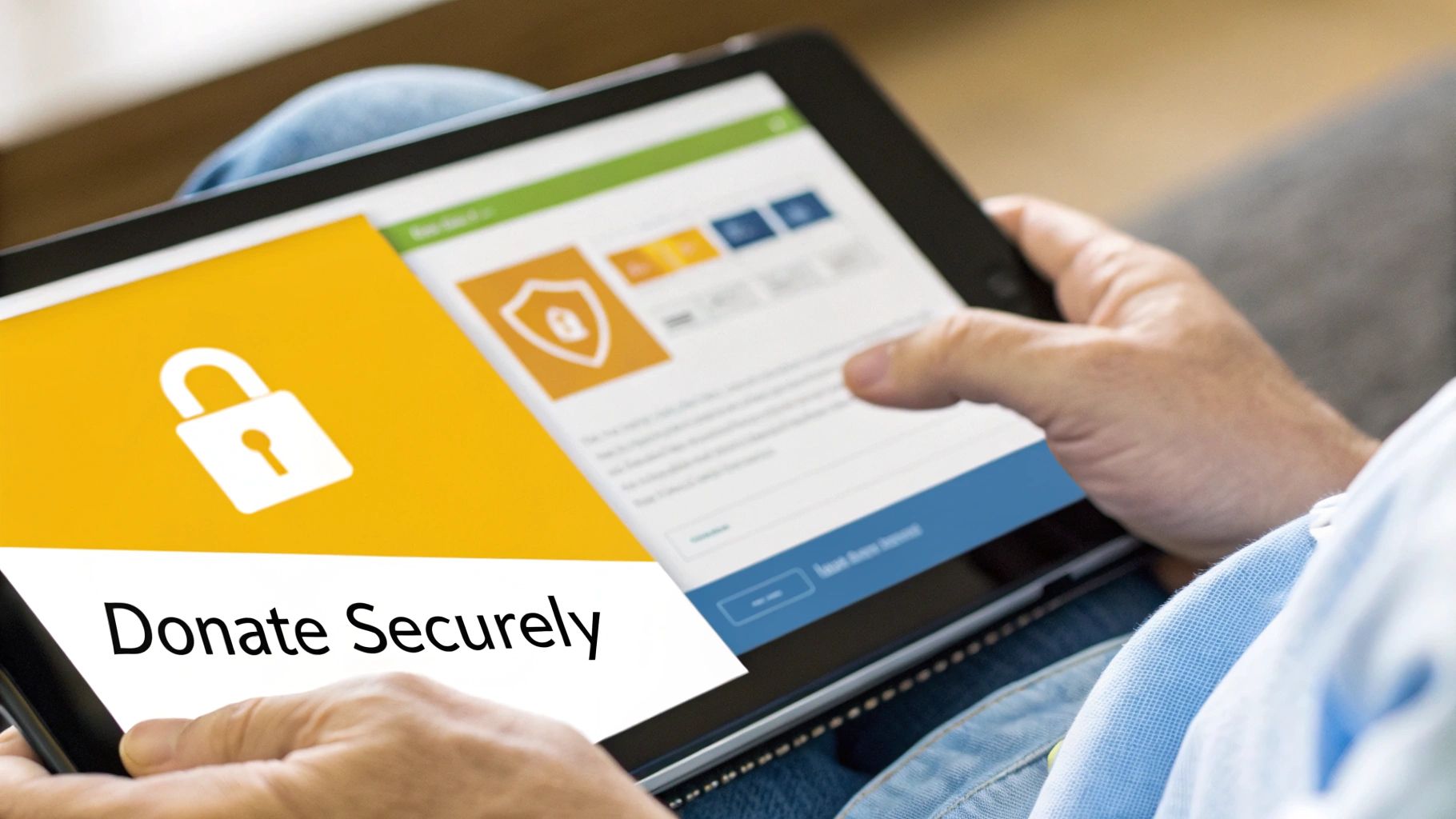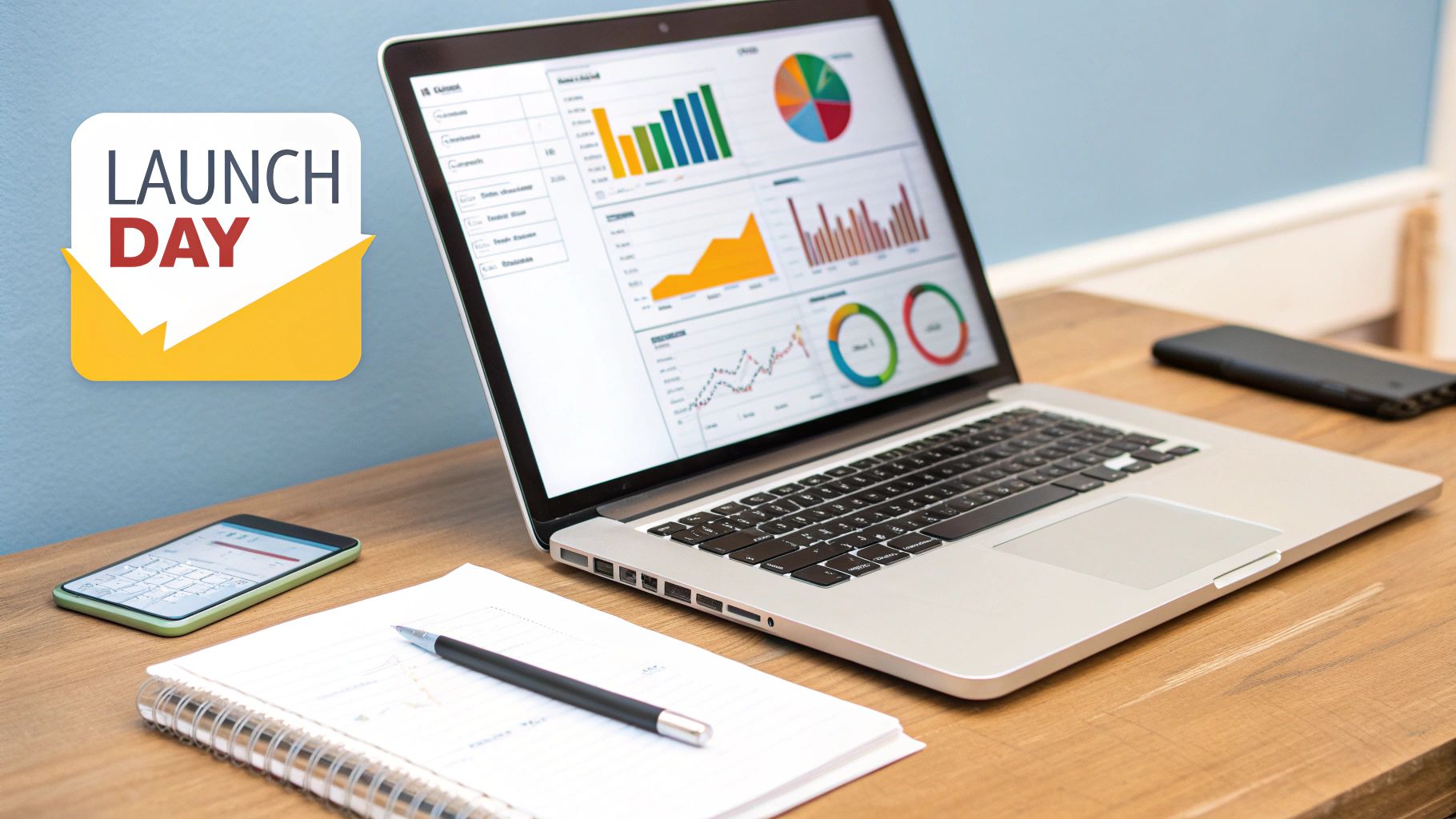A Guide to Web Development for Nonprofits

When we talk about web development for nonprofits, we’re really talking about building your organization’s digital home. It’s the one place online that you truly own and control, a central hub designed to rally support, drive donations, and share your mission with the world. Think of it less as a technical task and more as building a powerful engine for change.
Why Your Website Is Your Most Important Asset

It’s tempting to pour all your energy into social media, and those platforms are great for getting the word out. But they’re essentially rented space. You’re like a vendor at a busy market—subject to the landlord’s changing rules, unpredictable rent hikes, and the whims of the crowd.
Your website, on the other hand, is the building you own. It's your permanent digital headquarters.
This owned asset becomes the heart of your mission. It’s the one place where you can tell your story without character limits, guide every step of a visitor's journey, and cultivate genuine, lasting relationships with your community.
Owning Your Narrative and Impact
A dedicated website gives you the freedom to shape your message exactly how you want. You aren't at the mercy of a mysterious algorithm that might suddenly decide to hide your posts from your most dedicated followers. That kind of control is vital for building a brand that people recognize and trust.
Here’s why owning your platform is a game-changer:
- Direct Communication: You get a direct line to your supporters—donors, volunteers, and the people you serve—with no third-party platform getting in the way.
- Fundraising Control: You can build a seamless, secure donation process that inspires confidence and makes it easy for people to give. This alone can make a huge difference to your bottom line.
- Data Ownership: You gather valuable insights about who is visiting your site and what they care about, helping you make smarter decisions and refine your outreach over time.
Your website is more than an online brochure; it's the most reliable and effective tool for converting passive interest into active support. It’s the foundation upon which your entire digital strategy is built.
Future-Proofing Your Mission
As we move toward 2025, relying too heavily on social media is becoming a risky bet. Platform policies shift, algorithms change overnight, and what worked yesterday might not work tomorrow. Having your own website and email list gives you stability in an unpredictable digital world.
Performance is non-negotiable, too. Research shows that 25% of visitors will leave a site if it takes more than four seconds to load. You can explore more nonprofit website trends to see just how critical a fast, mobile-friendly experience has become. It's no longer a "nice-to-have"—it's the baseline expectation.
Building Your Website Blueprint for Maximum Impact

A great nonprofit website never starts with code or fancy design software. It begins with a rock-solid plan. Think of this as drawing up the architectural blueprints for your digital headquarters. If you skip this part, you're essentially building a house without a plan—it’s a recipe for a confusing layout, wasted effort, and a final product that doesn't really serve anyone.
This initial strategy makes sure every single piece of your website has a clear job to do. The first step in effective web development for nonprofits is figuring out exactly who you're trying to reach and what you want them to do once they find you.
Define Your Audience and Goals
Before you can build a site that connects with people, you have to know who those people are. Different groups come to your website for completely different reasons.
- Donors: They’re looking for proof of your impact and a dead-simple, trustworthy way to contribute.
- Volunteers: They need to find opportunities quickly and sign up without jumping through a bunch of hoops.
- Community Members: These folks might be looking for help, resources, or information about the services you provide.
Once you know your audience, you can set real, measurable goals. Vague ambitions like "raise awareness" won't cut it. You need concrete targets, like "Increase online donations by 20%" or "Boost volunteer sign-ups by 50%."
A well-defined blueprint aligns your organizational goals with your audience's needs, creating a direct path from their first visit to meaningful action. This clarity is the foundation of a high-impact website.
Mapping the User Journey and Site Structure
With your audience and goals clear, it's time to map out the visitor's experience. How does a potential donor get from your homepage to that final "thank you for your donation" page? What steps does a new volunteer take to find and apply for a role? Sketching out these paths helps you spot and remove roadblocks, guiding people smoothly toward your most important calls-to-action.
This exercise naturally flows into creating a sitemap—a simple, logical hierarchy of all the pages on your website. A good sitemap makes navigation feel intuitive, so visitors can find what they're looking for without getting frustrated. To really get this right, our guide on how to define project scope is a fantastic resource for this critical planning stage.
Finally, your blueprint needs a content strategy. This isn't just about what you're going to say, but how you say it. All of your content—from blog posts and impact stories to program descriptions—needs to speak directly to your different audiences, reinforcing your mission and giving them a reason to get involved. A solid plan ensures your story is told with passion and consistency across every corner of your site.
2. Choosing the Right Technology for Your Mission
Picking the right technology for your nonprofit's website can feel a lot like trying to choose the right vehicle for a cross-country trip. Do you need a simple, reliable sedan that’s easy to drive and gets you from A to B with no fuss? Or do you need a powerful, fully-customizable van that you can outfit for any adventure that comes your way?
There’s no single “best” answer. The right choice depends entirely on your specific mission, your budget, your team's technical comfort level, and where you plan on going in the future. It’s less about picking the flashiest option and more about finding the perfect fit for your unique journey.
Let's break down the most popular platforms to help you decide.
Comparing Popular CMS Platforms for Nonprofits
The Content Management System (CMS) is the engine of your website. It’s the platform you’ll use to write blog posts, update event details, and build new pages. This choice is foundational, impacting everything from how much time your staff spends on web updates to your ability to launch a new fundraising campaign quickly.
The data reveals a clear frontrunner in the nonprofit world. Research shows that WordPress.org is used by a staggering 58% of nonprofits. Platforms like Wix (7%) and Squarespace (6%) follow, popular for their all-in-one simplicity. To see more data on this, you can check out these website statistics for nonprofits.
Here's a comparison to help you weigh your options:
| Platform | Best For | Ease of Use | Customization | Typical Cost |
|---|---|---|---|---|
| WordPress.org | Organizations needing total flexibility, scalability, and control. Ideal for complex sites with custom features. | Moderate to Difficult | Virtually unlimited. Thousands of plugins and themes allow for endless possibilities. | Free (open-source), but requires paid hosting, themes, and premium plugins. |
| Squarespace | Small to mid-sized nonprofits that prioritize beautiful design and ease of use over complex functionality. | Easy | Good, but limited to the platform's templates and built-in features. Code injection is possible. | Monthly/annual subscription that includes hosting and support. |
| Wix | Beginners and small organizations looking for a simple, drag-and-drop website builder for a basic online presence. | Very Easy | Moderate. Offers a large app market, but less design freedom than Squarespace within templates. | Monthly/annual subscription with various tiers. |
Ultimately, choosing a CMS is a strategic decision. You want a platform that empowers your team, not one that creates a technical roadblock every time you want to make a simple change.
The best CMS isn’t the one with the most features—it’s the one that helps your team advance your mission without getting in the way.
Must-Have Integrations to Power Your Work
A great nonprofit website doesn't operate in a silo. It needs to communicate seamlessly with the other digital tools you rely on to run your organization. Think of it as your digital headquarters, with open lines of communication to your fundraising, marketing, and supporter management departments. This entire ecosystem of connected tools is often called a "technology stack." For a more detailed guide, see our post on how to choose the right technology stack.
Here are the critical connections your website needs to make:
Donation Platforms: A smooth, trustworthy giving experience is non-negotiable. Integrating your site directly with processors like Stripe, PayPal, or a nonprofit-specific tool like Classy or Givebutter makes donating secure and simple for your supporters.
Customer Relationship Management (CRM): Manually entering donor information is a huge time sink. By connecting your website forms directly to your CRM (like Salesforce or Bloomerang), you can automatically sync new donor and volunteer data, saving hours of administrative work.
Email Marketing Tools: Don't let interested visitors slip away. By integrating with services like Mailchimp or Constant Contact, you can add simple newsletter signup forms across your site to capture new subscribers and grow your community.
Designing for Donations, Trust, and Accessibility

When it comes to web development for nonprofits, a great design is about so much more than just looking good. It’s about building a digital space that feels trustworthy and naturally guides people to take action. Think of your website's design as a visual handshake—it’s the first impression that tells visitors your mission is solid, your work is secure, and their support truly matters.
Let’s use an analogy. Your homepage is the front door, your "About Us" page is the living room where you share your story, and the donation page is where you make your most important request. Every part of that journey needs to feel welcoming, intuitive, and safe. We achieve this by blending smart design with powerful storytelling and a genuine commitment to including everyone.
Creating a Seamless Donation Experience
The donation process is probably the single most important interaction on your entire site. The smallest bit of friction—a clunky form, a confusing step, or a missing security seal—can be enough to make someone change their mind and click away. With 63% of donors now preferring to give online, making this experience smooth is absolutely critical to your fundraising efforts.
The goal is simple: make giving feel effortless and secure. The donation form needs to be easy to find, work perfectly on a phone, and ask only for the information you truly need.
To build that all-important trust right on the page, make sure you include:
- Security Badges: Showcasing logos from well-known payment gateways and your SSL certificate is a quick, visual way to tell donors their information is safe.
- Clear Impact Statements: Connect the numbers to real-world outcomes. Instead of just asking for money, show what it accomplishes (e.g., "$50 provides a week of meals").
- Recurring Donation Options: For your most dedicated supporters, a simple checkbox to make their gift monthly is an incredible way to build sustainable support.
A trustworthy and straightforward donation process isn't just a nice feature; it's a direct reflection of your organization's professionalism and respect for its supporters. Every element should be designed to remove doubt and encourage generosity.
Designing for Every Supporter
Your mission is inclusive, and your website needs to be, too. That means building it so that everyone, including people with disabilities, can access your message and support your cause. Web accessibility isn’t a niche technical task—it’s an ethical imperative. It ensures your call to action can reach the widest possible audience, no matter their physical or cognitive abilities.
The gold standard here is following the Web Content Accessibility Guidelines (WCAG). This isn't as intimidating as it sounds; it involves practical steps that make your site better for everyone. For a much deeper dive, our guide explains how to make your website accessible in detail.
Key Accessibility Practices
Here’s the thing about accessibility—it makes the experience better for all of your visitors, not just those with disabilities. A clearly structured site with intuitive navigation is simply a well-designed site.
You can get started with these fundamentals:
- Use Alt Text for Images: This is descriptive text that screen readers announce to users who are blind or have low vision, telling them what's in the picture.
- Ensure Color Contrast: Text should stand out clearly from its background. There are free online tools that let you check your color combinations against WCAG standards.
- Enable Keyboard Navigation: Every button, link, and form on your site should be usable with just the tab, enter, and arrow keys—no mouse required.
- Write Clear and Simple Copy: Steer clear of jargon and complex sentences. Use headings, short paragraphs, and lists to break up text and make your content easier for everyone to digest.
Budgeting for Your Website and Measuring ROI
It’s easy to fall into the trap of seeing your website as just another line-item expense. That’s a mistake. Your website is a powerful, mission-critical investment—just like hiring a star fundraiser or opening a new program facility. It’s a core asset that works 24/7 to engage supporters, recruit volunteers, and drive the donations that fuel your work.
So, how much should you set aside? The honest answer is: it depends. A simple, elegant site for a small community food bank will have a very different price tag than a complex, multi-faceted platform for a national advocacy group. The key is to align your investment with your specific goals and what you need the site to do.
What Does a Nonprofit Website Cost
A website redesign is a serious investment, but it’s one that’s directly tied to boosting supporter engagement. The budget can swing pretty widely. A smaller, local nonprofit might spend between $8,000 and $15,000, while a larger organization needing sophisticated features and integrations could easily invest $35,000 to $50,000 or more.
The great news is that this spending delivers real, measurable results. One project we followed saw a 41% increase in conversion rates and an incredible 142% surge in lead generation post-launch. You can dig into more of these nonprofit website redesign outcomes to see what’s possible.
To give you a better feel for it, here’s a rough breakdown of what different budget levels can get you:
Basic ($8,000 - $15,000): This range usually covers a professional, template-based site built on a platform like Squarespace or a well-structured site using a premium WordPress theme. It's the perfect fit for smaller organizations that need a clean, modern online presence with standard features like a blog, contact forms, and a straightforward donation page.
Intermediate ($18,000 - $30,000): Stepping up to this level brings custom design elements and more advanced functionality into play. Think event calendars, volunteer portals, or basic integration with your CRM. This is the sweet spot for growing nonprofits looking to streamline their operations and give their community more ways to get involved.
Advanced ($35,000+): Here, you're talking about a fully custom website built from the ground up. This budget accommodates deep integrations—like connecting seamlessly with Salesforce—building out bespoke resource libraries, or creating unique, feature-rich member portals. This is for established organizations with very specific and complex digital needs.
Proving Your Website's Value with ROI
Getting your board to approve the budget often comes down to one thing: proving you’ll get a return on that investment. This means you have to look past "vanity metrics" like raw page views and focus on the numbers that actually connect to your mission’s bottom line. You need to show them how this website will be a primary driver of your organization's growth.
The secret to getting buy-in is to shift the conversation from "How much will this cost?" to "What will this achieve?" A great website doesn't just spend money; it raises it, recruits for it, and builds a passionate community around your cause.
Start tracking the Key Performance Indicators (KPIs) that tell a compelling story about your website’s impact:
- Donation Conversion Rate: Of all the people who land on your donation page, what percentage actually complete a gift?
- Volunteer Sign-Ups: How many new volunteers did the website bring in last quarter?
- Email List Growth: How many new subscribers did the website add to your newsletter?
- Cost Per Acquisition: How much are you spending in marketing to get one new donor through the website?
Getting a handle on the financial impact of your digital efforts is absolutely vital. For anyone who wants to go deeper, there are some fantastic resources out there on measuring SEO ROI that offer a great framework. When you present this kind of hard data, you transform your website from a simple expense into an indispensable engine for your mission.
7. Launching and Maintaining Your Website for Long-Term Success

Hitting "go live" on your new website is an exciting moment, but it's really the starting line, not the finish. It’s a lot like planting a garden. You've done the hard work of preparing the soil and planting the seeds, but now you have to keep watering and weeding to help it grow. Ongoing maintenance is what protects all that initial effort and makes sure your site remains a powerful tool for your mission.
A smooth launch all comes down to a solid pre-flight check. It's so tempting to rush this final step, but that's where tiny mistakes can slip through and cause big headaches later. Before flipping the switch, get your team together for one last, thorough review.
Your Essential Pre-Launch Checklist
This isn't just about catching a few typos. It’s a full technical and strategic once-over to guarantee your site is ready to perform from the second it goes live.
- Final Testing: This is non-negotiable. Click every link, fill out every form, and test every single button. Critically, run through the entire donation process yourself. Do all of this on different browsers and on desktop, tablet, and mobile devices to ensure a seamless experience for everyone.
- Technical SEO: Make sure all the behind-the-scenes work is in place. Check that you have a sitemap, your URLs make sense, and that search engines can actually find and understand your pages.
- Analytics Setup: Get your measurement tools ready. Install and configure your analytics platform, like Google Analytics 4, and set up goals for the actions that matter most—like completing a donation or signing up for your newsletter.
A website is a living asset, not a static brochure. Consistent maintenance is the difference between a site that drives your mission forward and one that slowly becomes irrelevant and insecure.
Creating a Sustainable Maintenance Plan
Once your site is out in the world, the work shifts to keeping it healthy, secure, and effective. A proactive maintenance plan is your best defense against small issues spiraling into major problems.
At the very least, your plan has to include regular updates for your core software and any plugins you use. This is crucial for patching security holes as soon as they're discovered.
But maintenance goes beyond just security. Your site needs fresh content to give visitors a reason to come back and to show search engines that you're active and relevant. Regularly sharing impact stories, news, and updates on your blog builds credibility and keeps your community engaged. This ongoing effort is a core part of effective web development for nonprofits, turning your website into a tool that delivers value long after the launch party is over.
Common Questions About Web Development for Nonprofits
Diving into a new website project can feel a bit overwhelming, and it's natural to have a lot of questions. We get it. To help clear things up, here are some straight-to-the-point answers to the questions we hear most often from nonprofit leaders.
How Much Should a Nonprofit Budget for a Website?
This is the big one, and the honest answer is: it depends. The cost of a website can swing pretty widely based on what you need it to do.
For a smaller organization that just needs a clean, professional online presence, a simple website might fall in the $8,000 to $15,000 range. If you're a mid-sized nonprofit looking for more functionality—think event calendars, volunteer sign-ups, or a blog—you're likely looking at an investment between $18,000 and $30,000.
For larger, more established organizations that need sophisticated features like a deep CRM integration or custom-built tools, budgets typically start at $35,000 and go up from there. It's helpful to stop thinking of this as just a cost and start seeing it for what it is: a crucial investment in your fundraising and community-building engine.
How Long Does Building a Nonprofit Website Take?
Just like the budget, the timeline is all about the scope of the project. A straightforward website, perhaps built using a well-designed template, can often go from kickoff to launch in about 6-10 weeks.
A fully custom-designed site, on the other hand, is a more involved process. When you factor in the deep strategy sessions, unique design work, development, content creation, and a few rounds of feedback, you're usually looking at a 12-20 week timeline.
The single most important feature is a seamless, trustworthy, and mobile-friendly donation process. It must be easy to find, simple to use, and clearly communicate the impact of a gift.
This isn't just a transaction; it's a moment of trust. The whole experience has to inspire confidence, from the moment they click "Donate" to the confirmation screen. Using a reputable payment processor and making sure the page is completely secure aren't just best practices—they're fundamental to building the long-term relationships that fuel your mission.